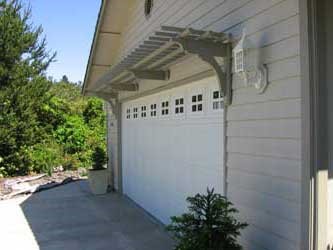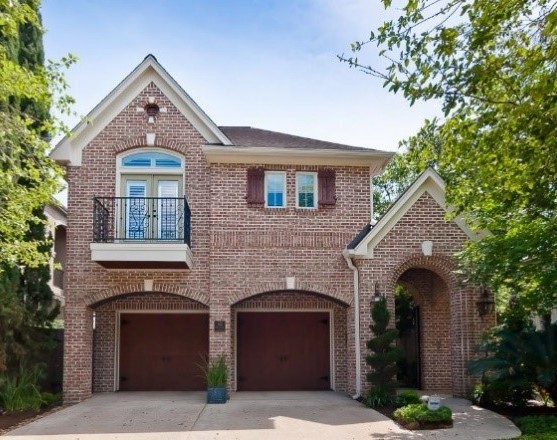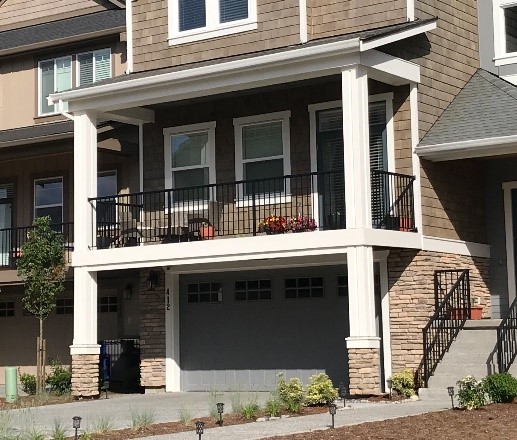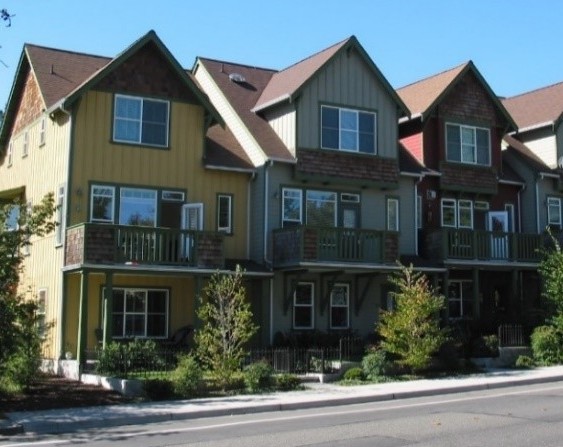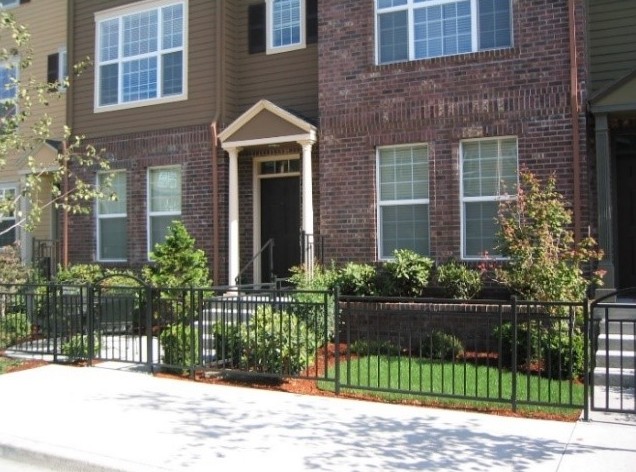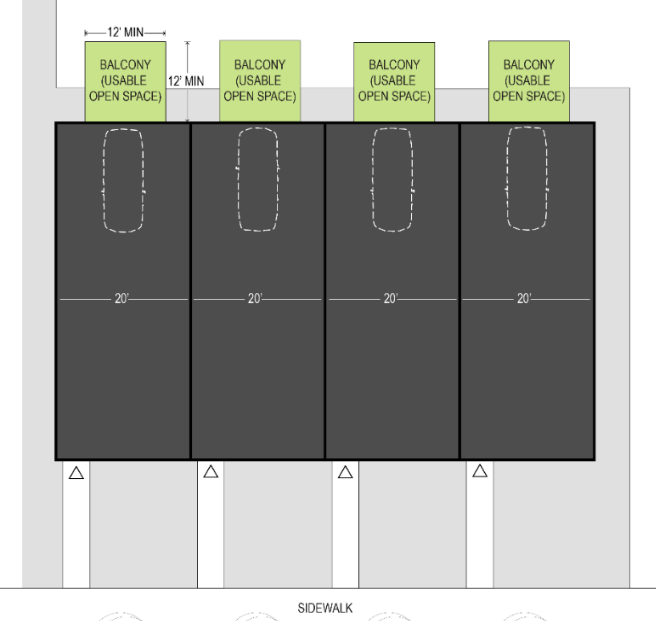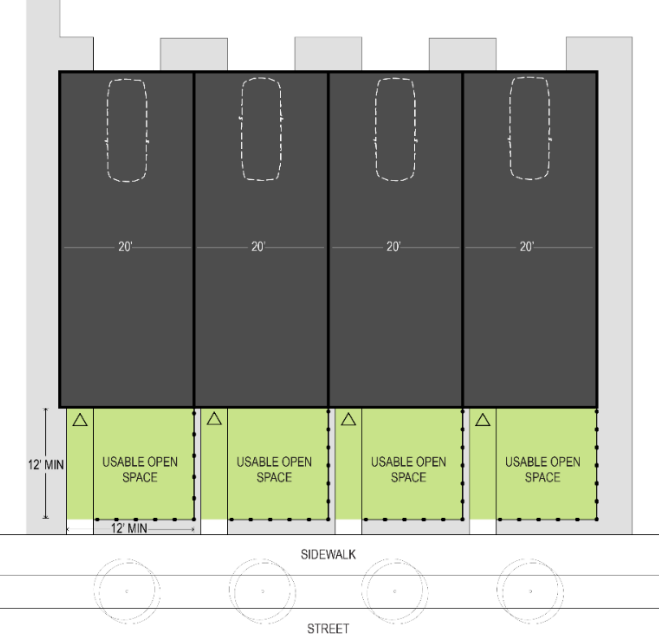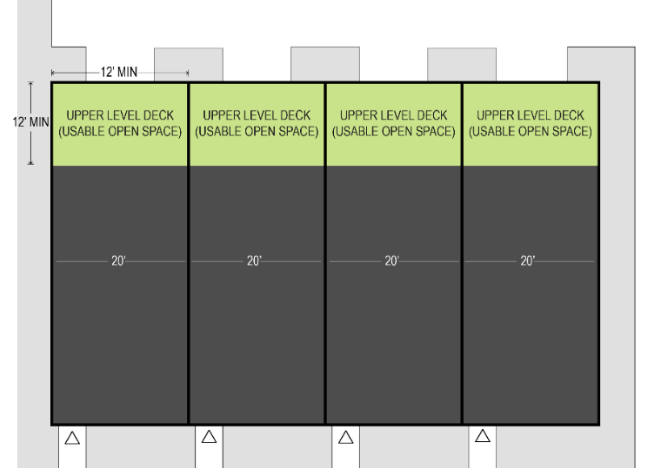Chapter 10.47
RESIDENTIAL USE STANDARDS
Sections:
10.47.020 Residential structures.
10.47.030 Residential Design Guidelines.
10.47.040 Accessory dwelling units (ADU).
10.47.050 Single-family dwellings.
10.47.060 Single-family – Cluster.
10.47.070 Single-family – Courtyard.
10.47.080 Infill-cottage housing (two to three units).
10.47.090 Cottage housing (four or more units).
10.47.140 Live-work dwellings.
10.47.150 Multifamily development.
10.47.170 Alley access and improvements.
10.47.180 Manufactured home communities.
10.47.010 Purpose.
The purpose of the residential use standards is to provide a concise reference to requirements applicable to residential uses and specific housing types. (Ord. 2019-35 § 6)
10.47.015 Applicability.
The standards described in this chapter apply to the establishment of the applicable housing types, except as otherwise noted in this chapter or in any cited codes or documents. Applicability includes the following situations:
(1) New construction.
(2) The conversion of existing structure(s) to a particular housing type. When existing structure(s) are converted to housing, regardless of whether they contain housing units already, the applicant shall demonstrate compliance with the standards that apply to the proposed housing type(s). (Ord. 2020-35 § 3 (Exh. A))
10.47.020 Residential structures.
All residential structures where allowed by Chapter 10.10 WCC, District Use Chart, shall meet the following standards unless otherwise regulated within this code. All residential dwellings shall meet the following provisions:
(1) All dwellings shall be placed on a permanent foundation with the space between the bottom of the home and the ground enclosed by concrete or an approved concrete product which can be either load-bearing or decorative.
(2) A dwelling shall be not less than 14 feet in width at the narrowest point of its first story.
(3) All designated manufactured homes located within the city on an individual lot of record, not within a manufactured home park, shall be new, not previously titled to a retail purchaser, no more than three years old on the date of installation, and composed of at least two fully enclosed parallel sections. (Ord. 2019-35 § 6)
10.47.030 Residential Design Guidelines.
The document entitled Wenatchee Residential Design Guidelines, as adopted by Resolution No. 2019-43, and any later edition thereof, shall be and hereby is adopted and incorporated into the Wenatchee City Code by this reference as if fully set forth herein. A copy of the most current adopted Residential Design Guidelines shall be maintained at the city clerk’s office and the city planning department available for review during normal business hours of the city. (Ord. 2019-35 § 6)
10.47.040 Accessory dwelling units (ADU).
All accessory dwelling units, where defined in WCC 10.08.040 and where allowed by Chapter 10.10 WCC, District Use Chart, shall meet the following standards unless otherwise regulated within this code:
(1) Purpose. The purpose of this section is:
(a) To regulate the establishment of accessory dwelling units within or in conjunction with single-family dwellings while preserving the character of single-family neighborhoods;
(b) To make it possible for adult children to provide care and support to a parent or other relatives in need of assistance;
(c) To provide increased security and companionship for homeowners;
(d) To provide the opportunity for homeowners to gain the extra income necessary to help meet the rising costs of home ownership; or to provide for the care of disabled persons within their own homes.
(2) Standards for All Accessory Dwelling Units, Including Those Attached to the Main Residence and Those That Are in a Separate Building but on the Same Property.
(a) Form. An ADU may be created within, or detached from, any existing or new single-family dwelling as a subordinate use. Dwelling units that are physically separated from the primary structure, that is, in a separate building, are “detached accessory dwelling units” (DADUs).
(b) Number. No more than one ADU may be created per legal lot of record.
(c) Occupancy. Only the property owner, which shall include title holders and contract purchasers, may apply for an ADU. For properties in the RS, RL, and RF zones, the property owner shall occupy either the primary dwelling or the ADU as their principal residence for at least six months of the year.
(d) Minimum Parking. A minimum of three parking spaces shall be provided for the principal and accessory dwelling units. On nonarterial streets where on-street parking is available (as approved by the city engineer) abutting the lot, only two off-street spaces shall be provided for the principal and accessory dwelling units.
(e) Maximum Size. In no case shall an ADU be larger than 50 percent of the habitable floor area of the principal dwelling, nor more than 800 square feet of gross floor area.
(f) Living Facilities. The ADU shall include, at a minimum, kitchen, bathroom and sleeping facilities.
(g) Entrance Location. If a separate outside entrance is necessary for an ADU located within the primary dwelling, that entrance shall be located either on the rear or side of the building.
(h) Home Occupations. A home occupation may be permitted in either the primary dwelling or the ADU but not in both if otherwise allowed in the WCC.
(i) Utilities. Utilities for an ADU shall be metered jointly with the primary dwelling except as otherwise required by ordinance.
(j) Addressing. An address shall be assigned by the city at the time of building permit issuance.
(k) Covenants. The property owner shall file a restrictive covenant with Chelan County’s auditor’s office for the subject property prior to final building inspection approval for the ADU. The recorded information shall:
(i) Identify the address of the property;
(ii) State that the owner(s) must reside in either the principal or accessory dwelling unit if located in the RS, RL, or RF zoning districts;
(iii) State that the owner(s) will notify any prospective purchasers of the limitations of the ADU;
(iv) State that the ADU shall not be subdivided or otherwise segregated in ownership from the primary dwelling unit; and
(v) Provide for the removal of the ADU if any of the requirements of this title are violated.
(l) Usable Open Space. No additional open space is required for the ADU or DADU. Lots containing an ADU or DADU must demonstrate compliance with the open space standards for single-family residences as set forth in WCC 10.47.050(2)(e) before an ADU or DADU can be legally established.
(3) Standards for All Detached Accessory Dwelling Units (DADU).
(a) Setbacks. DADUs shall meet rear and side accessory structure setback requirements and shall be set back equal to or further than the primary dwelling from the front property line.
(b) Maximum Height.
(i) DADUs with a roof pitch of 6:12 or greater: 25 feet.
(ii) DADUs with a roof pitch of less than 6:12: 20 feet.
(iii) Special Side Setback Standards for DADUs. From a height of 15 feet at the minimum side setback, DADUs shall step back at a 45-degree angle away from the side property line as shown in Figure 10.47.040(3) below. Structures set back further than the minimum side setback shall not encroach into the setback/daylight plane.
Figure 10.47.040(3)
Height/setback plane for DADUs along side setbacks.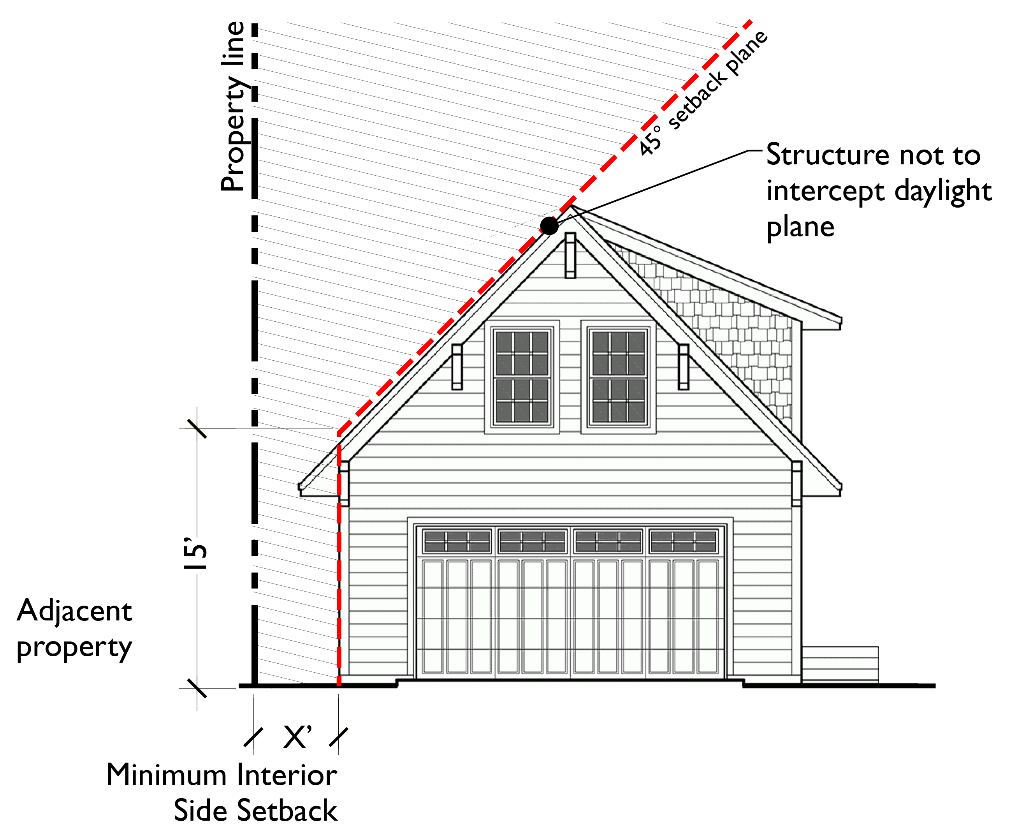
(Ord. 2020-35 § 3 (Exh. A); Ord. 2019-35 §§ 6, 9)
10.47.050 Single-family dwellings.
All single-family dwellings, where defined in WCC 10.08.055 and where allowed by Chapter 10.10 WCC, District Use Chart, shall meet the following standards unless otherwise regulated within this code:
(1) Purpose.
(a) To enhance the character of the street and neighborhood.
(b) To maintain “eyes on the street” for safety to pedestrians and to create a more welcoming and interesting streetscape.
(c) To deemphasize garages and driveways as major visual elements along the street.
(d) To provide usable open space for residents.
(2) Standards.
(a) Entry Standards.
(i) Clear and obvious pedestrian access between the sidewalk (or the street if there is no sidewalk) and the building entry is required for new dwellings. The driveway may be used for pedestrian access.
(ii) All new dwellings shall provide a covered pedestrian entry with minimum weather protection of four feet by four feet (a covered porch or recessed entry).
(iii) See the street setback exception for roofed porches and covered entries in WCC 10.46.080(2)(a)(iii).
(b) Driveway Standards.
(i) Minimum and maximum driveway widths for single-family houses facing a public street as measured at the property/right-of-way line are set forth in Table 10.47.050(2)(b) below. Paved areas for vehicle storage or other uses may be wider if they are no less than five feet from the street property/right-of-way line.
|
Use Type |
Minimum Width |
Maximum Width |
|
|---|---|---|---|
|
Residential |
|
|
|
|
|
Lot width = 50 feet or greater |
10 feet |
18 feet |
|
|
Lot width < 50 feet |
10 feet |
12 feet or 18 feet if shared with adjacent lot |
(c) Garage and Carport Setbacks. Garages and carports are subject to the setback standards in Chapter 10.46 WCC.
(d) Garage Standards. Garages (attached or detached) may occupy no more than 50 percent of the width of the ground-level facade facing the street. Garage doors may exceed this limit up to a maximum of 65 percent of the width of the ground-level facade facing the street provided at least two of the following design details are utilized:
(i) A decorative trellis over at least the entire width of the garage door(s).
(ii) A window or windows are placed above the garage on a second story or attic wall.
(iii) A balcony that extends out over the garage and includes decorative support columns.
(iv) Utilizing all single vehicle car doors as an alternative to wider garage doors suitable for two-car garages.
(v) Windows on the garage door.
(vi) Decorative details on the garage door. Standard squares on a garage door will not qualify as a decorative detail.
|
|
|
|
|
A decorative trellis over the garage door. |
A balcony over the garage, single doors (instead of a wider double door), and windows above the garage on a second story. |
A balcony over garage with decorative support columns. |
(e) Standards for Minimum Usable Open Space.
(i) All new single-family dwelling units shall provide a contiguous open space to the side or rear of the dwelling with a minimum dimension of 15 feet on all sides. This space may not be used for vehicle or other large object storage but be available for human activity. The open space may be in the street setback if facing a private lane.
(ii) The open space(s) shall be equivalent to 10 percent (minimum) of the lot area. For example, a 4,000-square-foot lot would require a contiguous open space of at least 400 square feet, or 20 feet by 20 feet in area. Figure 10.47.050(2)(e) illustrates some configurations that comply for residences with alley access.
(iii) Drive aisles shall not count in the calculations for usable open space.
(iv) Additions shall not create or increase any nonconformity with this standard.
Figure 10.47.050(2)(e)
Examples of how to provide the minimum amount of usable open space.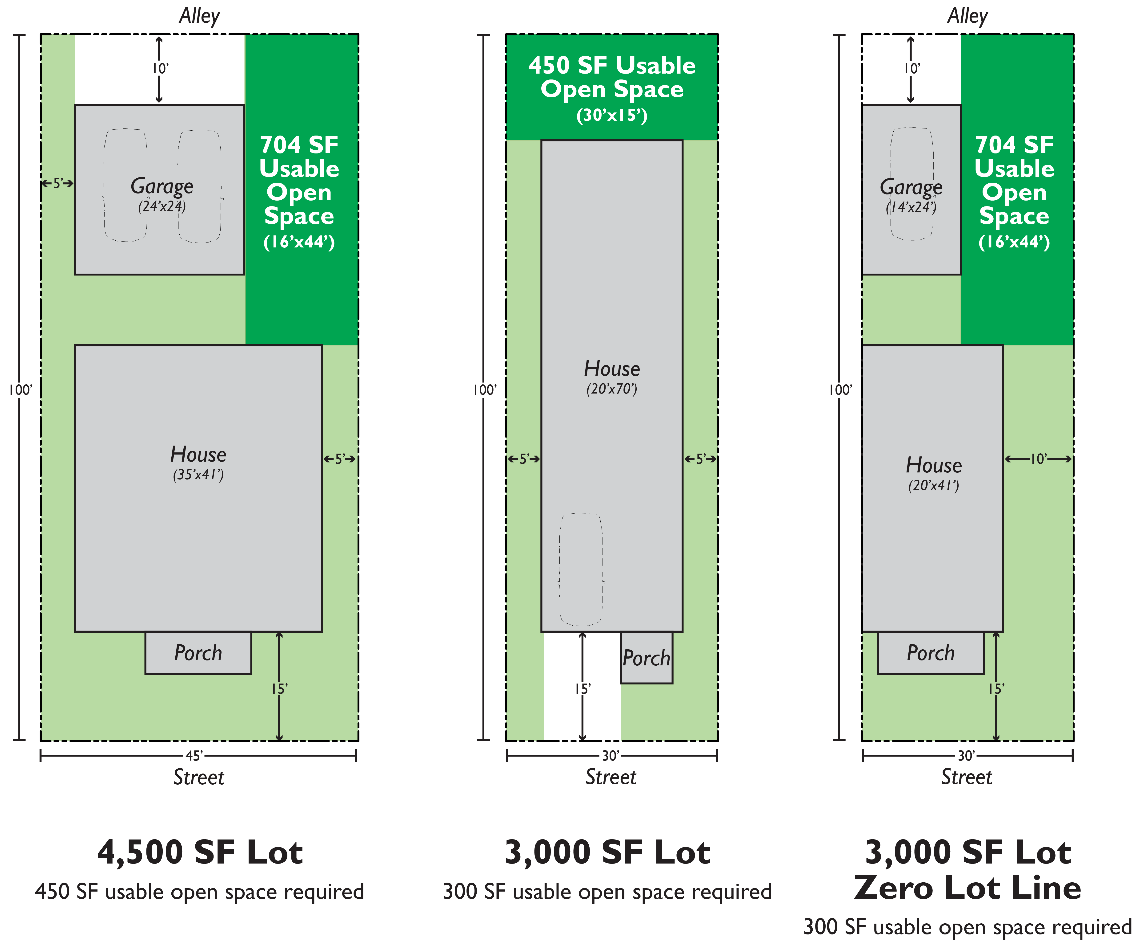
(f) Multiple Single-Family Dwellings on One Lot. Multiple single-family dwellings may be placed on one lot provided the dwellings are located and designed in a manner so that the lot could be subdivided in the future and meet applicable lot dimensions, setbacks, and lot coverage standards applicable to the zoning district and other applicable standards in this title and WCC Title 11. The burden of proof for demonstrating compliance with the applicable standards for the potential short subdivision shall be on the applicant. Submittal requirements will therefore exceed those for a standard building permit. Additional information includes, but may not be limited to, a site plan that includes the “proposed” lot lines, access and utilities, any applicable easements, dimensions, and any other applicable information necessary to demonstrate compliance. Permitting multiple single-family dwellings on a single lot in no way guarantees the ability to subdivide in the future. Future proposed land divisions would need to meet the standards in place at the time of application. (Ord. 2020-35 § 3 (Exh. A); Ord. 2019-35 § 6)
10.47.060 Single-family – Cluster.
All single-family cluster developments, where defined in WCC 10.08.055 and where allowed by Chapter 10.10 WCC, District Use Chart, shall meet the following standards unless otherwise regulated within this code:
(1) Single-family cluster developments are subject to the specialized lot dimension and lot coverage standards in WCC 10.46.020 that allow for lot sizes close to 50 percent of the size of standard lots. However, single-family cluster developments are subject to the standard maximum building height limits and maximum density prescribed for the applicable zone along with the standards for single-family dwellings in WCC 10.47.050.
(a) All such lot reductions shall be compensated for by an equivalent amount of land area in open space to be preserved and maintained for its scenic value, for recreation, or conservation purposes. The open space shall be clearly labeled and numbered as a tract with the following language inserted on any and all plats filed for record:
This tract is held in reserve as a permanent open space and shall not be considered as a building lot, or encroached upon in any manner.
(b) The open space created and set aside shall remain for preservation, recreation and conservation purposes, and shall be accessible without trespassing on private property, to all residents of the subdivision or, where the land has been deeded to the city of Wenatchee, to the public.
(2) As an alternative to the cluster provisions in subsection (1) of this section, lots may be exempted from minimum lot area, depth, width, and rear setback standards, provided they are arranged in clusters of four to 12 dwelling units around a centralized common open space and meet the following standards:
(a) Development parameters based on compliance with the provisions herein shall be placed on the final plat or final unit lot subdivision.
(b) Cluster single-family developments shall meet zoning district density standards.
(c) Setbacks.
(i) Dwellings built along streets and side property lines along the perimeter of the development are subject to the applicable street and side setbacks in WCC 10.46.020.
(ii) Dwellings built along rear property lines shall maintain 10-foot minimum setbacks.
(iii) The minimum internal setback between dwellings is 10 feet.
(d) At least 50 percent of the dwellings shall abut a common open space meeting the standards in subsection (2)(g) of this section. Direct access to the common open space shall be provided for each dwelling by a paved walkway. See also Residential Design Guideline D.3 (Residential Open Space Elements).
(e) Site Design and Orientation. Dwellings within a cluster development shall be oriented to promote a sense of community, both within the development and, with respect to the larger community, outside of the development. A cluster subdivision shall not be designed to “turn its back” on the surrounding neighborhood by locating rear yards to face a public street.
(i) Clear and obvious pedestrian access between the sidewalk (or the street if there is no sidewalk) and the dwelling entry is required.
(ii) All new dwellings adjacent to a street shall meet the Residential Design Guidelines, especially Section C.1 (Ground related units facing streets, common pathways, or common open space), Section C.2.1 (Pedestrian connectivity within multi-unit residential development with more than one building) and Section E.5.1 (Building entrances: configuration and details).
(iii) Common open space shall be provided in a centrally located focal area for the development and abut at least 50 percent of the dwellings in the cluster subdivision (see subsection (2)(g) of this section). Direct access to the common open space shall be provided for each dwelling by a paved walkway. See also Residential Design Guideline Section D.3 (Residential open space elements).
(iv) One existing single-family dwelling may be incorporated into a cluster development. Nonconforming residences with respect to architectural standards shall be permitted.
(v) A cluster development may contain one community building that is clearly incidental in use and similar in size and architectural design of the dwellings. Such community building shall be commonly owned by the residents.
(vi) Cul-de-sacs are not permitted within a single-family cluster development, unless it can be demonstrated that no other configuration is feasible.
(f) Building Design and Orientation. See Section E in the Residential Design Guidelines.
(g) Common Open Space Standards.
(i) A common open space is required for each cluster of four to 12 dwellings.
(ii) A minimum of 300 square feet of common open space shall be provided per dwelling unit.
(iii) Each common open space shall be a minimum of 1,500 square feet in size with no dimension less than 25 feet, regardless of the number of dwelling units.
(iv) Common open space shall meet the requirements of the Residential Design Guidelines, especially Section C.3.2.b, and be improved for passive or active recreational use. Examples may include, but are not limited to, courtyards, non-commercial orchards, landscaped picnic areas or gardens, wildlife viewing areas, etc.
(v) Fences are not allowed within any common open space area.
(vi) Common open space shall be located in a separate tract or tracts and owned in common by all property owners.
(h) Private Open Space. Each dwelling shall include a minimum of 400 square feet of private open space (in addition to common open space). The private open space shall have no dimension less than 10 feet, be located adjacent to the unit which it serves and feature direct access to the private open space via door. Examples include a semi-private garden space between a dwelling and the common open space.
(i) Surface water management facilities may be included in the required private and common open space areas provided they are designed to provide functional recreational uses for the residents.
(j) Driveway, Access, Parking, and Garages.
(i) Dwellings adjacent to a street are subject to applicable driveway and garage standards for single-family dwellings in WCC 10.47.050.
(ii) Parking and garages for individual dwellings may be configured separately on each lot or dwelling site (attached or detached) or clustered in shared parking areas.
(iii) Parking areas and garages (individual or shared) shall not be sited adjacent to common open spaces. The director may allow exceptions where site and/or building design features are integrated to minimize the impacts of garages and parking areas on the function and character of the common open space.
(iv) Where parking areas and garages are provided on each dwelling lot or site, shared private lanes may be used to access up to six dwelling units. Shared private lanes are subject to the private lane standards in WCC 11.20.020, except:
(A) Maximum length: 150 feet.
(B) Minimum width: 15 feet paved lane within a 20-foot-wide easement.
(v) Where parking areas are clustered in shared arrangements, such parking areas and access lanes are subject to citywide fire-safety and emergency access standards.
(k) Landscaping. See Residential Design Guidelines Section D.1.
(l) Covenants enforced by a homeowner’s association shall be required to include the perpetual maintenance of all common areas and open spaces and preclude the conversion to another use. (Ord. 2019-35 § 6)
10.47.070 Single-family – Courtyard.
All single-family courtyard developments, where defined in WCC 10.08.055 and where allowed by Chapter 10.10 WCC, District Use Chart, shall meet the following standards unless otherwise regulated within this code:
(1) Purpose. To allow greater flexibility to integrate infill single-family lots served by a shared private lane.
(2) Standards.
(a) Maximum number of lots served by a shared private lane: six (this includes lots fronting the street on either side of the private lane as shown in Figure 10.47.070(3)).
(b) Shared private lanes are subject to the private lane standards in WCC 11.20.020, except:
(i) Maximum length: 150 feet (see Figure 10.47.070(3) for examples).
(ii) Minimum width: 15-foot paved lane within a 20-foot-wide easement.
(iii) Maximum number of lots: six in a single-family courtyard development.
(c) Setback Standards and Options for Lots Served by a Shared Private Lane.
(i) Lots fronting on a public street and containing a shared private lane on one side are considered corner lots for the purpose of determining setbacks (see WCC 10.46.080(2)(c) for details).
(ii) Open space standards of WCC 10.47.050(e) apply.
(iii) Garages facing a shared private lane easement shall be set back at least 20 feet from the easement line.
(iv) For interior lots featuring a shared private lane and easement extending through one side of the lot, no street setback is required. Such lots are subject to side setbacks on three sides. For the side of the lot featuring the access easement, the side setback is applied from the edge of the easement. The rear setback is located opposite the shared private lane.
(v) Lots sited at the terminus of a shared private lane easement are exempt from the street setback requirement. Such lots shall meet side setbacks on three sides and a rear setback on one side.
(3) See Figure 10.47.070(3) for examples of subdivisions served by shared private lanes and clarification of street, interior, and rear setbacks.
Figure 10.47.070(3)
Examples of courtyard single-family developments.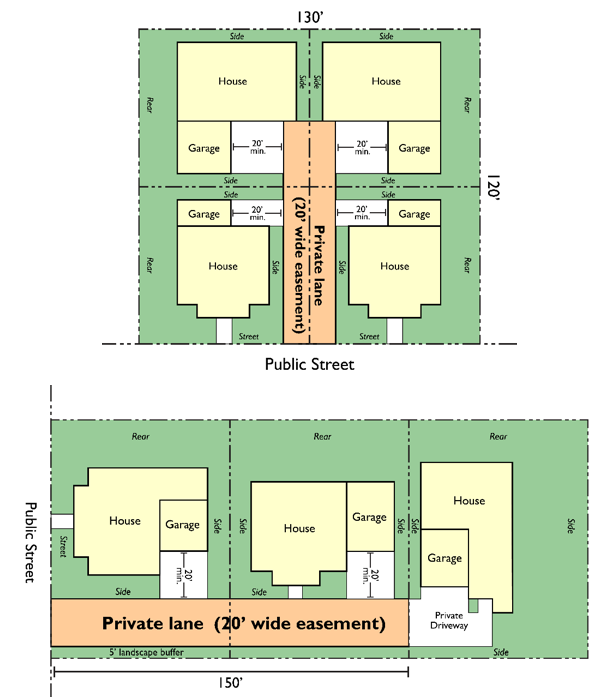
(Ord. 2019-35 § 6)
10.47.080 Infill-cottage housing (two to three units).
Infill-cottage housing developments refer to a type of cottage housing (defined in WCC 10.08.050) that features between two to three cottage dwellings. Infill-cottage housing developments, where allowed by Chapter 10.10 WCC, District Use Chart, shall meet the following standards unless otherwise regulated within this code:
(1) Purpose.
(a) To provide housing types that are responsive to changing household demographics (e.g., retirees, small families, young professionals).
(b) To provide opportunities for more affordable housing within single-family neighborhoods.
(c) To ensure compatibility with neighboring uses.
(d) To provide opportunities for infill development consistent with goals of the Wenatchee urban area comprehensive plan.
(2) Standards.
(a) Occupancy. Cottage housing development options include ownership, rental, condominium, and subdivision. One existing single-family dwelling may be incorporated into an infill-cottage housing development. Nonconforming residences with respect to architectural standards shall be permitted.
(b) Minimum and Maximum Number of Cottages.
(i) Two units minimum.
(ii) Three units maximum.
(c) Maximum Cottage Size. The total floor area for cottages shall not be larger than 1,000 square feet gross floor area.
(d) Density. For the purposes of complying with the maximum density of the applicable zoning district, each cottage shall be counted as one-half dwelling unit. For example, for an existing lot that qualifies for between 1.0 and 1.49 dwelling units, two cottages complying with the provisions herein may be built. For an existing lot that qualifies for between 1.50 and 1.99 dwelling units, three cottages may be built.
(e) Setbacks.
(i) Cottages built on existing individual lots shall be subject to the standard street and side setbacks in WCC 10.46.020. The minimum rear setback shall be 15 feet.
(ii) Where multiple cottages are clustered on a parent lot or the units on that lot are subdivided as a unit lot subdivision, the standard front, side, and rear setbacks in WCC 10.46.020 apply to the lot lines of the parent lot(s). The minimum internal setback between cottages is 10 feet.
(iii) Two cottages may share a common wall with no side setback in a duplex arrangement.
(f) Access Standards.
(i) Cottages, where subdivided on their own individual lots, may be accessed by private individual driveways, provided such driveways meet the standards of Table 10.47.050(2)(b).
(ii) A shared driveway meeting the requirements of WCC 11.20.020(11)(a)(i) through (xi) is allowed. Such shared driveway may be used to access up to three cottage dwellings, provided all other applicable standards are met.
(g) Entry Standards. See Residential Design Guidelines, especially Sections C.1, C.2.1 and E.5.1.
(h) Parking and Garages.
(i) Each cottage dwelling unit shall provide at least one off-street parking space per bedroom, up to two parking spaces per unit.
(ii) Garages with a footprint of up to 300 square feet may be attached to individual cottages provided such garages meet setback standards set forth in subsection (2)(h)(iii) of this section.
(iii) Garages and carports are subject to the setback standards in Chapter 10.46 WCC.
(iv) Garages and other parking facilities for the cottages may be located or clustered to the side or rear of cottages. Detached and shared garages or carports are limited in size to 300 square feet footprint per cottage (e.g., up to 900 square feet if shared between three cottages).
(i) Maximum Height. Notwithstanding WCC 10.46.020, the maximum height of cottages built under this section is 25 feet where a minimum roof slope of 6:12 for all parts of the roof above 18 feet is provided. Otherwise, the maximum cottage height is 18 feet.
(j) Minimum Open Space. Cottage developments may meet their open space standards either with private open spaces or common shared open spaces.
(i) Cottages developed on private individual lots are subject to the minimum usable open space standards for single-family dwellings in WCC 10.47.050(e).
(ii) Cottages opting to include shared common open spaces shall integrate such space located between and directly accessible to the cottages. The common open space shall contain at least 250 square feet per unit with no dimension less than 20 feet. Common open space shall be improved for passive or active recreational use. Common open spaces are subject to the Residential Design Guidelines Section C.3.2.b. Examples may include, but are not limited to, courtyards, open lawn areas, landscaped picnic areas or gardens. Common open space shall be located in a separate tract or tracts, and owned in common by all property owners.
(k) Landscaping. See Chapter 10.62 WCC.
(l) Covenants enforced by a homeowner’s association shall be required to include the perpetual maintenance of all common areas and open spaces and preclude the conversion to another use.
Figure 10.47.080(2)
Example configurations of developments with three cottages.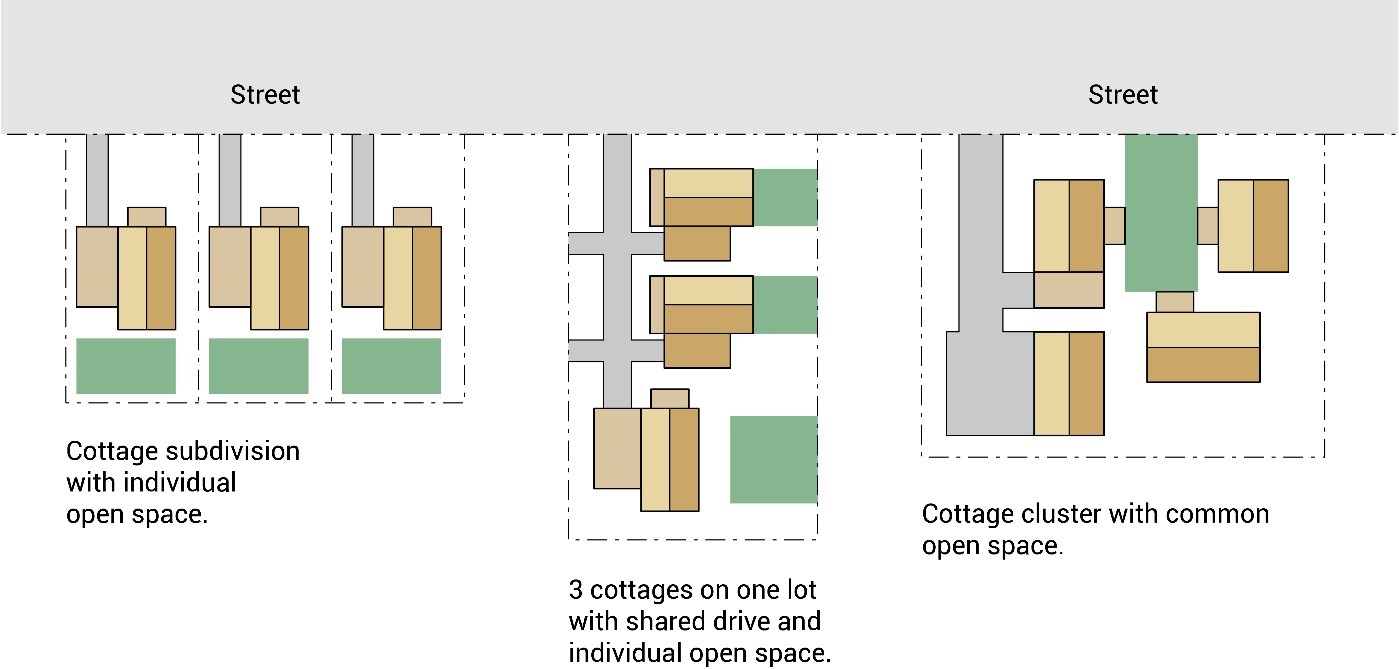
(Ord. 2022-33 § 3 (Exh. A); Ord. 2020-35 § 3 (Exh. A); Ord. 2019-35 §§ 6, 9)
10.47.090 Cottage housing (four or more units).
Cottage housing, where defined in WCC 10.08.050 and where allowed by Chapter 10.10 WCC, District Use Chart, shall meet the following standards when four or more units are proposed unless otherwise regulated within this code:
(1) Purpose.
(a) To provide housing types that are responsive to changing household demographics (e.g., retirees, small families, young professionals).
(b) To provide opportunities for more affordable housing within single-family neighborhoods.
(c) To encourage creation of functional usable open space in residential communities.
(d) To promote neighborhood interaction and safety through design.
(e) To ensure compatibility with neighboring uses.
(f) To provide opportunities for infill development consistent with goals of the Wenatchee urban area comprehensive plan.
Figure 10.47.090(1)(a)
Cottage housing development examples.
Left example: Note the transition between the common open space on the left and the cottages includes a semi-private garden space and a porch. The middle and right images illustrate the standard “commons” as a simple green space for informal recreation activities. In all examples, the units orient towards the open space and include porches and a small semi-private garden.
Figure 10.47.090(1)(b)
Cottage housing site plan example.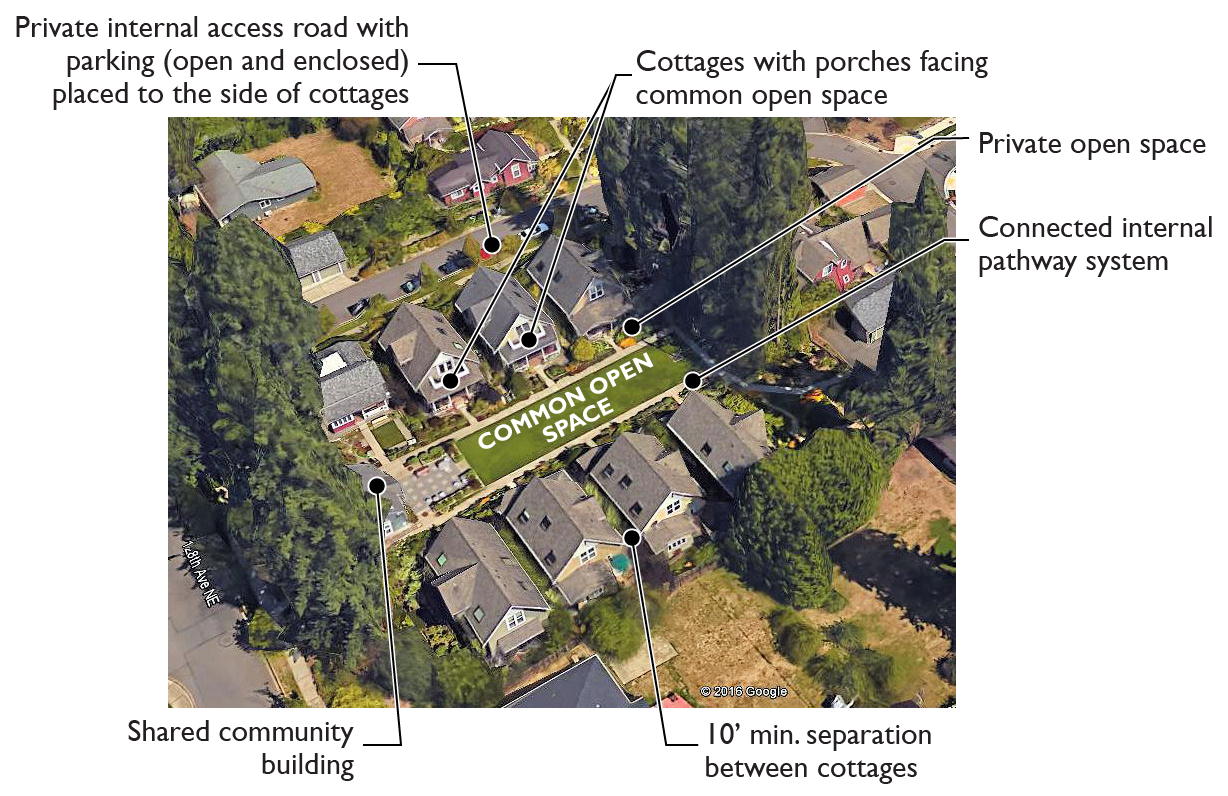
(2) Standards.
(a) Cottage housing development options include ownership, rental, condominium, and subdivision.
(b) Subdivision. Where a cottage housing development involves a subdivision, development parameters as determined by the city shall be placed on the final plat or final unit lot subdivision.
(c) Minimum and Maximum Number of Cottages.
(i) A single cottage housing development shall include a minimum of four dwelling units.
(ii) Four to 12 cottage structures may make up a cluster (a grouping of cottages situated around a common open space or pedestrian circulation network, each with an entry facing the courtyard or pedestrian system).
(d) Maximum Cottage Size. The total floor area for a cottage shall be no greater than 1,200 square feet; provided, the ground floor is not greater than 800 square feet.
(e) Density. For the purposes of complying with the maximum density of the applicable zoning district, each cottage shall be counted as one-half dwelling unit. For example, for an existing lot that qualifies for three dwelling units would qualify for six cottages.
(f) Setbacks.
(i) Cottages built along streets are subject to the applicable street setbacks in Chapter 10.46 WCC.
(ii) Cottages built adjacent to side property lines are subject to the applicable side setback.
(iii) Cottages built along rear property lines of the parent lot(s) shall maintain a 10-foot minimum setback in the RS and RL zones and a five-foot minimum setback in all other applicable zones.
(iv) The minimum internal setback between cottages is 10 feet, except that two cottages may share a common wall as in a duplex configuration. Within a given development, up to one-half of the cottages may feature the shared wall/duplex configuration.
(g) Site Design and Orientation. Dwellings within a cottage housing development shall be oriented to promote a sense of community, both within the development and, with respect to the larger community, outside of the cottage project. A cottage development shall not be designed to “turn its back” on the surrounding neighborhood by locating rear yards to face a public street.
(i) Clear and obvious pedestrian access between the sidewalk (or the street if there is no sidewalk) and the building entry is required for new cottage dwellings.
(ii) All new cottage dwellings adjacent to a street shall meet the Residential Design Guidelines, especially Sections C.1 (Ground related units facing streets, common pathways, or common open space), C.2.1 (Pedestrian connectivity within multi-unit residential development with more than one building) and E.5.1 (Building entrances: configuration and details).
(iii) Common open space shall be provided in a centrally located focal area for the development and abut at least 50 percent of the cottages in the development (see open space standards below); direct access to the common open space shall be provided for each cottage by a paved walkway. See also Residential Design Guideline D.3, Residential Open Space Elements.
(iv) One existing single-family dwelling may be incorporated into a cottage housing development of six or more cottages as a residence. Nonconforming residences with respect to architectural standards shall be permitted.
(v) A cottage housing development may contain one community building that is clearly incidental in use and similar in size and architectural design of cottages. Such community building shall be located on the same site as the cottage housing development and be commonly owned by the residents.
(vi) Cul-de-sacs are not permitted within a cottage development, unless it can be demonstrated that no other configuration is feasible.
(h) Building Design and Orientation. See Section E in the Residential Design Guidelines.
(i) Open Space.
(i) A common open space is required for each cottage cluster.
(ii) A minimum of 200 square feet of common open space shall be provided per dwelling unit.
(A) Common open space within a development shall be a minimum of 1,000 square feet in size with no dimension less than 15 feet, regardless of the number of dwelling units.
(B) Common open space shall meet the requirements of the Residential Design Guidelines, especially Section C.3.2.b, and be improved for passive or active recreational use. Examples may include, but are not limited to, courtyards, noncommercial orchards, landscaped picnic areas or gardens, wildlife viewing areas, etc.
(C) Fences are not allowed within any common open space area.
(D) Common open space shall be located in a separate tract or tracts and owned in common by all property owners.
See Figures 10.47.090(1)(a) and (b) for examples.
(iii) Each cottage unit shall include a minimum of 200 square feet of private open space (in addition to common open space). The private open space shall have no dimension less than 10 feet, be located adjacent to the unit which it serves and feature direct access to the private open space via door. Examples include a semi-private garden space between a dwelling and the common open space. See Figures 10.47.090(1)(a) and (b) for examples.
(iv) Surface water management facilities may be included in the open space calculation for meeting minimum requirements, if it can be demonstrated that they are designed so that residents can use the space similar to other open space designations.
(j) Access, Driveways, Parking, and Garages.
(i) Unless a higher classification of road is required per public works preapproved plans or by the city engineer to provide for consistency with the Wenatchee urban area plan, internal access and circulation shall meet the requirements of, Fire Apparatus Access Road, of the most current edition of the International Fire Code, as amended. Where a standard residential subdivision or binding site plan is proposed associated with these developments, the standards provided in WCC 11.20.020, Streets, shall also apply.
(ii) Each cottage dwelling unit shall provide at least one off-street parking space per bedroom, up to two parking spaces per unit.
(iii) Cottages adjacent to a street are subject to applicable driveway and garage standards for single-family dwellings in WCC 10.47.050.
(iv) Parking areas shall be located to the side or rear of cottage clusters (not between the cottages and the street front unless no other configuration is feasible, as determined by the director). Landscaping in form of hedges or architectural barriers is required to screen surface parking lots for neighboring properties and common open spaces.
(v) Private garages are allowed to be attached to or detached from individual cottages if less than 250 square feet in size and accessible by an alley or shared access. Private garages shall match the architectural style of the units and meet the same separation requirements as adjoining units.
(vi) Enclosed parking areas may be grouped into a single structure. Individual garage doors shall be one car width.
(k) Landscaping. Cottage housing developments shall adhere to the landscape and screening chapter, Chapter 10.62 WCC. See also Residential Design Guidelines Section D.1.
(l) Architectural Design. See Residential Design Guidelines Section E: Building Design.
(m) Covenants enforced by a homeowner’s association shall be required to include the perpetual maintenance of all common areas and open spaces and preclude the conversion to another use. (Ord. 2019-35 § 6)
10.47.100 Duplexes.
All duplexes, where defined in WCC 10.08.055 and where allowed by Chapter 10.10 WCC, District Use Chart, shall meet the following standards unless otherwise regulated within this code:
(1) Purpose. The intent of these standards is to allow for residential infill that is compatible with the character and scale of existing residential neighborhoods without adversely impacting neighbors, the broader neighborhood, and the community as a whole. Furthermore, the purpose of these duplex design standards is to:
(a) To enhance the character of the street and neighborhood.
(b) To maintain “eyes on the street” for safety to pedestrians and to create a more welcoming and interesting streetscape.
(c) To deemphasize garages and driveways as major visual elements along the street.
(d) To provide usable open space for residents.
(2) Standards.
(a) Off-Street Parking. Each dwelling unit shall have one parking stall per bedroom up to two stalls per dwelling unit.
(b) Access. Access to principal or minor arterial streets shall be limited to a single driveway (18 feet maximum width) per unit unless accessed from an alley or as otherwise approved by the city engineer.
(c) Architectural Design. See Residential Design Guidelines Section E: Building Design.
(3) Minimum Usable Open Space. Duplexes shall include usable open space for each dwelling unit:
(a) Each unit shall include a contiguous open space with a minimum dimension of 15 feet on all sides. The director will allow a reduced minimum dimension of 10 feet on all sides provided multiple usable open spaces are integrated such as upper level decks or balconies.
(b) The combined open spaces shall be equivalent to 10 percent (minimum) of the duplex lot area. For example, an 8,000-square-foot lot would require a usable open spaces of at least 800 square feet (e.g., 20 feet by 20 feet (400 square feet) for each unit). Unenclosed ground-level porches and patio areas and upper floor decks may be included in the open space calculations.
(c) Street setbacks may be used to meet this standard provided they are defined with a fence meeting the standards of WCC 10.48.130.
(d) Drive aisles shall not count in the calculations for usable open space.
(e) Additions shall not create or increase any nonconformity with this standard.
Figure 10.47.100(a)
Example of integrating a duplex’s minimum usable open space into the street setback.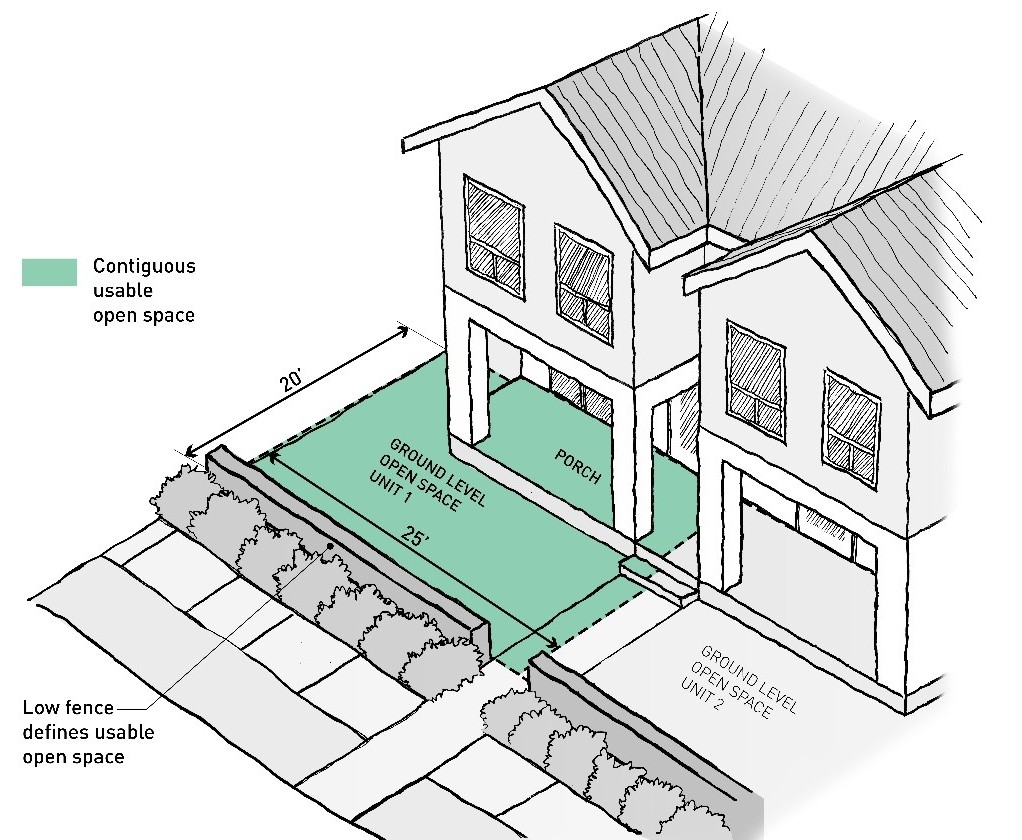
(Ord. 2019-35 § 6)
10.47.110 Patio homes.
All patio homes, where defined in WCC 10.08.115 and where allowed by Chapter 10.10 WCC, District Use Chart, shall meet the following standards unless otherwise regulated within this code:
(1) Purpose. The intent of these standards is to allow for residential infill that is compatible with the character and scale of existing residential neighborhoods without adversely impacting neighbors, the broader neighborhood, and the community as a whole. Furthermore, the purpose of these patio design standards is to:
(a) To enhance the character of the street and neighborhood.
(b) To maintain “eyes on the street” for safety to pedestrians and to create a more welcoming and interesting streetscape.
(c) To deemphasize garages and driveways as major visual elements along the street.
(d) To provide usable open space for residents.
(2) Standards. Patio homes are subject to the same standards as duplexes, as set forth in WCC 10.47.100. (Ord. 2019-35 § 6)
10.47.120 Courtyard housing.
All courtyard housing developments, where defined in WCC 10.08.050 and where allowed by Chapter 10.10 WCC, District Use Chart, are subject to compliance with the Residential Design Guidelines and shall meet the following standards unless otherwise regulated within this code:
Courtyard housing is characterized by attached multifamily units arranged around a courtyard. The units may be all ground related, like townhouses, or a combination of ground related and upper story residences. Courtyard housing on a single lot is a special case of “multifamily development,” but standards for courtyard housing are separated here because of that housing type’s unique configuration around a courtyard or open space.
(1) Purpose.
(a) To provide housing types that are responsive to changing household demographics (e.g., retirees, small families, young professionals).
(b) To provide opportunities for more affordable housing within single-family neighborhoods.
(c) To encourage creation of functional usable open space in a pleasant setting.
(d) To promote neighborhood interaction and safety through design.
(e) To ensure compatibility with neighboring uses.
(f) To provide opportunities for infill development consistent with goals of the Wenatchee urban area comprehensive plan.
Figure 10.47.120
Courtyard housing development examples.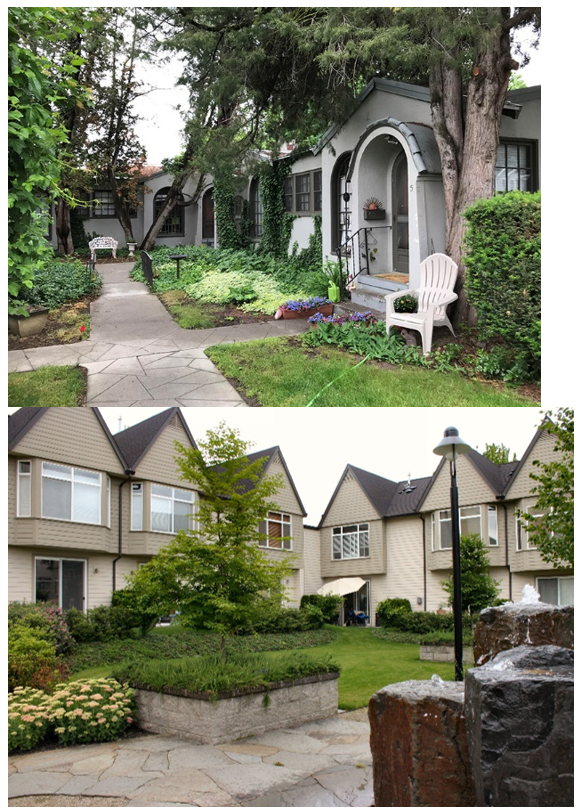
(2) Standards.
(a) Courtyard housing development options include ownership, rental, condominium, and subdivision.
(b) Subdivision. Where a courtyard housing development involves a subdivision, development parameters, as determined by the city, may be placed on the final plat or final unit lot subdivision.
(c) Minimum and Maximum Number of Dwelling Units.
(i) A single courtyard housing development shall include a minimum of four dwelling units, up to a maximum of 24 units. The city may allow development of more than 24 dwelling units if all of the purposes stated above are achieved.
(d) Density. The maximum density shall be as described in WCC 10.46.020, except that dwelling units under 1,000 square feet (excluding unenclosed front porches) may be counted as three-quarters of a unit (resulting in a one-third density bonus).
(e) Setbacks.
(i) Courtyard buildings facing public streets are subject to the applicable street setbacks in Chapter 10.46 WCC.
(ii) Courtyard buildings built along the side yards of adjacent properties (not in the development) are subject to the applicable side setback.
(iii) Courtyards built along rear property lines of adjacent properties (not in the development) shall maintain 10-foot minimum setbacks in the RS and RL zones and five-foot minimum setbacks in all other applicable zones.
(iv) There is no minimum internal setback between units within a courtyard development.
(f) Site Design and Orientation. Dwellings within a courtyard housing development shall be oriented to promote a sense of community, both within the development, and with respect to the larger community, outside of the courtyard project.
(i) Clear and obvious pedestrian access and visual access between the sidewalk (or the street if there is no sidewalk) and the courtyard is required for new courtyard dwellings.
(ii) All new courtyard dwellings adjacent to a street shall meet the Residential Design Guidelines, especially Sections C.1 (Ground related units facing streets, common pathways, or common open space), C.2.1 (Pedestrian connectivity within multi-unit residential development with more than one building) and E.5.1 (Building entrances: configuration and details).
(iii) Common open space shall be provided in a centrally located focal area for the development and abut at least 50 percent of the courtyards in the development (see open space standards below); direct access to the common open space shall be provided for each courtyard by a paved walkway.
(g) Building Design and Orientation. See Section E in the Residential Design Guidelines.
(h) Open Space.
(i) A common open space is required for each courtyard cluster.
(ii) A minimum of 200 square feet of common open space shall be provided per dwelling unit.
(A) Common open space within a development shall be a minimum of 800 square feet in size with no dimension less than 15 feet, regardless of the number of dwelling units.
(B) Common open space shall meet the requirements of the Residential Design Guidelines, especially Section C.3.2.b, and be improved for passive or active recreational use. Examples may include, but are not limited to, courtyards, orchards, landscaped picnic areas or gardens.
(C) Fences are not allowed within any common open space area.
(D) Common open space shall be located in a separate tract or tracts and owned in common by all property owners.
(E) Setbacks, porches and other measures required in Residential Design Guideline C.1.1 shall not be counted as common open space.
(iii) Surface water management facilities may be included in the open space calculation for meeting minimum requirements, if it can be demonstrated that they are designed so that residents can use the space similar to other open space designations.
(i) Access, Parking, and Garages.
(i) Unless a higher classification of road is required per public works preapproved plans or by the city engineer to provide for consistency with the Wenatchee urban area plan, internal access and circulation shall meet the requirements of, Fire Apparatus Access Road, of the most current edition of the International Fire Code, as amended. Where a standard residential subdivision or binding site plan is proposed associated with these developments, the standards provided in WCC 11.20.020, Streets, shall also apply.
(ii) Each courtyard dwelling unit shall provide one off-street parking space per bedroom, up to two parking spaces per unit.
(iii) Parking areas shall be located to the side or rear of courtyard units (not between the courtyard and the street front unless no other configuration is feasible, as determined by the city). Landscaping in the form of hedges or architectural barriers is required to screen surface parking lots from neighboring properties and common open spaces.
(iv) Private garages are allowed to be attached to or detached from individual courtyard units if less than 250 square feet in size and accessible by an alley or shared private lane. Private garages shall match the architectural style of the courtyard units.
(v) Enclosed parking areas may be grouped together within one or more structures. Individual garage doors shall be one car width.
(j) Landscaping. Courtyard housing developments shall adhere to the landscape and screening chapter, Chapter 10.62 WCC. See also Residential Design Guidelines Section D.1.
(k) Covenants enforced by a homeowner’s association shall be required to include the perpetual maintenance of all common areas and open spaces and preclude the conversion to another use. (Ord. 2020-35 § 3 (Exh. A); Ord. 2019-35 § 6)
10.47.130 Townhouses.
All townhouses, as defined in WCC 10.08.135 and where allowed by Chapter 10.10 WCC, District Use Chart, are subject to compliance with the Residential Design Guidelines and shall meet the following standards unless otherwise regulated within this code:
(1) Purpose.
(a) To provide housing types that are responsive to changing household demographics (e.g., retirees, small families, young professionals).
(b) To encourage creation of functional usable open space in residential communities.
(c) To enhance the streetscape and promote neighborhood interaction and safety through design.
(d) To ensure compatibility with neighboring uses.
(e) To enhance design character and livability of townhouse developments.
(f) To provide opportunities for infill development consistent with goals of the Wenatchee urban area comprehensive plan.
(2) Standards.
(a) Setbacks. The minimum setbacks set forth in Chapter 10.46 WCC apply to development frontage and external side and rear setbacks of the entire townhouse development. Townhouse units within a single development are exempt from internal side and rear setbacks unless otherwise noted below. However, if the development includes the creation of new lots, the new development shall conform to the provisions of WCC 11.32.080, Unit lot subdivisions.
(i) Townhouses built along and oriented to public streets are subject to the applicable street setbacks in Chapter 10.46 WCC. Additionally, the setbacks for garages accessing a public street apply.
(ii) Townhouses built along side property lines of adjacent properties are subject to the applicable side setbacks in Chapter 10.46 WCC.
(iii) Townhouses built along rear property lines of adjacent properties shall maintain 10-foot minimum setbacks in the RS and RL zones and five-foot minimum setbacks in all other applicable zones.
(iv) The minimum internal setback between townhouse buildings built around and facing a pathway is 15 feet between the facades of each building.
(v) The minimum setback for townhouses (including porches and covered entries) not fronting on a public street shall be:
(A) Ten feet from the back edge of the sidewalk or 15 feet from the edge of roadway/driveway pavement for an internal drive (pursuant to subsection (2)(d) of this section).
(B) Fifteen feet from a private lane easement or tract.
(C) The minimum setback for a garage facing a private lane or internal drive aisle shall be at least five feet further from the building facade facing the private lane or internal drive aisle, including a porch or covered entry, and no less than 20 feet from the edge of roadway/driveway pavement and sidewalk if applicable.
(vi) See also requirements for ground related residential units in Residential Design Guidelines Section C.1.1.
(b) Entries. See Residential Design Guidelines Section E.5.1.
(c) Front-Loaded Townhouses. Private driveways (maximum 12 feet wide) and garages facing the street (single-car width and a maximum 10 feet wide) are allowed in the following circumstances:
(i) Where townhouse units are at least 30 feet wide. See Figure 10.47.130(2)(c) below for examples; and
(ii) Where townhouses front a street other than a designated principal or minor arterial.
Figure 10.47.130(2)(c)
Townhouse garage access configurations – acceptable and unacceptable examples.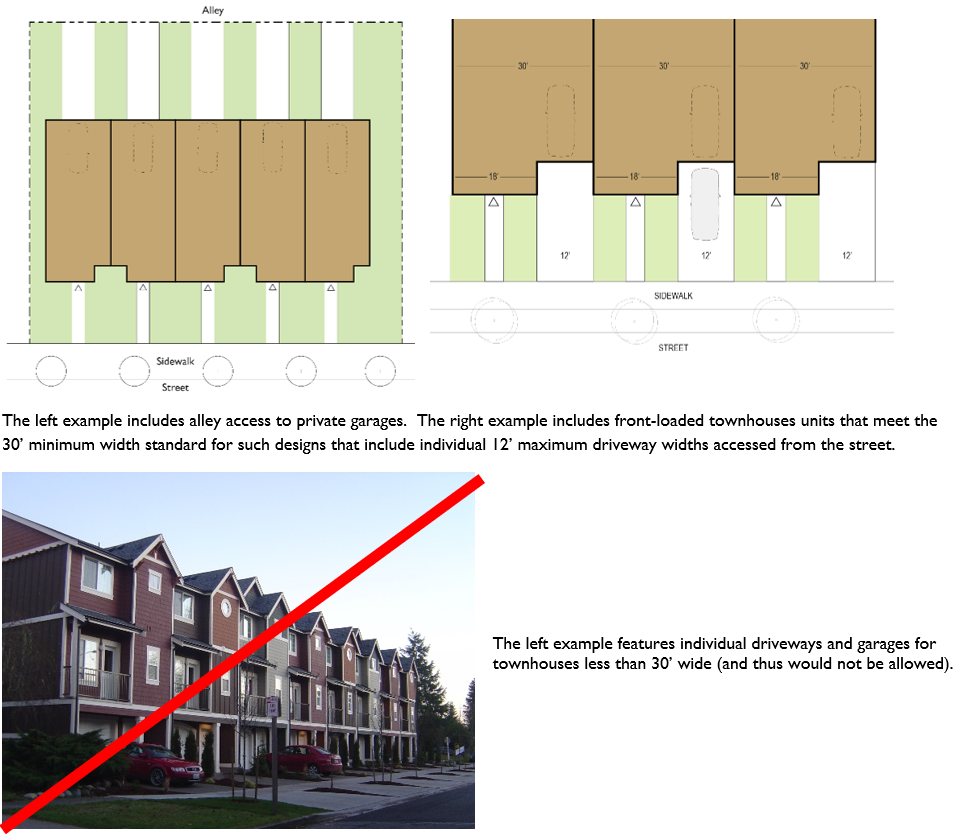
(d) Townhouses with Shared Access.
(i) Unless a higher classification of road is required per public works preapproved plans or by the city engineer to provide for consistency with the Wenatchee urban area plan, internal access and circulation within a townhouse development shall meet the requirements of, Fire Apparatus Access Road, of the most current edition of the International Fire Code, as amended. Where a standard residential subdivision or binding site plan is proposed associated with these developments, the standards provided in WCC 11.20.020, Streets, shall also apply.
(ii) Minimum building separation across internal drive aisles shall be 24 feet. Projections into this minimum building separation standard are permitted for each building consistent with the reduced side setback provisions referenced in WCC 10.46.080(4). The purpose is to provide adequate vehicular turning radius, allow for landscaping elements on at least one side, and to provide adequate light and air on both sides of the dwelling units and vehicle areas, which often function as usable open space for residents.
(iii) Portions of internal drive aisles within townhouse developments that have parking spaces that are directly adjacent shall meet the dimensional standards in WCC 10.60.030.
(e) Parking. Off-street parking standards for townhouses are set forth in WCC 10.60.080 as a type of multifamily dwelling (based on the number of bedrooms).
(f) Usable Open Space. Townhouse dwellings shall provide open space at least equal to 10 percent of the gross floor area. The required open space may be provided by one or more of the following:
(i) Private ground-level open space that is directly adjacent and accessible to dwelling units. Such space shall have minimum dimensions of at least 12 feet on all sides and be configured to accommodate human activity such as outdoor eating, gardening, toddler play, etc. Street setbacks from private lanes or drives may be used to meet this standard, provided they are defined with a fence meeting standards of WCC 10.48.130.
(ii) Balconies, roof decks or porches.
|
|
|
|
The lower left example includes usable open space in the front yard. The lower right example includes an upper level deck the full width of the unit. The right example uses a balcony that’s placed over the garage driveway. |
|
|
|
|
(g) Building Design. See Residential Design Guidelines Section E. (Ord. 2020-35 § 3 (Exh. A); Ord. 2019-35 §§ 6, 9)
10.47.140 Live-work dwellings.
All live-work dwellings, where defined in WCC 10.08.095 and where allowed by Chapter 10.10 WCC, District Use Chart, are subject to compliance with the Residential Design Guidelines and shall meet the following standards unless otherwise regulated within this code:
A live-work dwelling is a dwelling unit designed to accommodate a small commercial enterprise on the ground floor and a residential unit above and/or behind. A live-work dwelling may be designed as any type of household living dwelling unit. All live-work dwellings, where allowed by Chapter 10.10 WCC, District Use Chart, shall meet the following standards unless otherwise regulated within this code:
(1) Purpose. To allow for the opportunity to combine live/work functions into one dwelling.
(2) Standards.
(a) Permitted nonresidential uses may be those that are permitted in the applicable zone or overlay designation as established by Chapter 10.10 WCC, District Use Chart.
(b) See standards in other subsections of Chapters 10.46 and 10.47 WCC as well as the Residential Design Guidelines for the applicable dwelling type the live-work use resides in.
(c) The nonresidential use may occupy up to 50 percent of the gross floor area of the live-work dwelling.
(d) The ground floor shall be designed to accommodate nonresidential uses. This includes an area along the building frontage with:
(i) Minimum floor to ceiling height: 13 feet.
(ii) A ground floor interior room facing a public entrance suitable for business uses at least 250 square feet in floor area.
(e) The residential use and the nonresidential use are subject to the provisions of Chapter 10.60 WCC. Exception: Where nonresidential net floor area is less than 1,000 square feet and where on-street parking is available along the site’s frontage, uses that require less than four spaces per 1,000 square feet of net floor area per WCC 10.60.080 are exempt from additional off-street parking spaces. (Ord. 2019-35 § 6)
10.47.150 Multifamily development.
All multifamily dwellings, as defined in WCC 10.08.055, and where allowed by Chapter 10.10 WCC, District Use Chart, are subject to compliance with the Residential Design Guidelines and shall meet the following standards unless otherwise regulated within this code. Exception: Courtyard housing (see WCC 10.47.120) and townhouses (see WCC 10.47.130) are exempt from the standards herein.
(1) Purpose.
(a) To provide housing types that are responsive to changing household demographics (e.g., retirees, small families, young professionals).
(b) To provide opportunities for more affordable housing close to transit, employment and services.
(c) To ensure compatibility with neighboring uses.
(d) To provide opportunities for infill development consistent with goals of the Wenatchee urban area comprehensive plan.
Figure 10.47.150(1)
Multifamily housing development examples.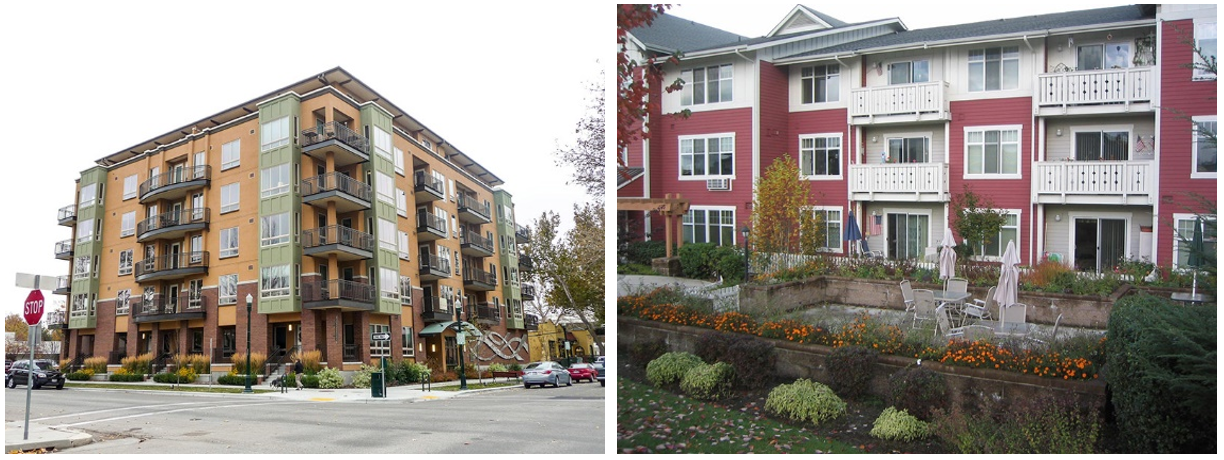
(2) Standards.
(a) Multifamily housing development options include ownership, rental, and condominium.
(b) Density. The maximum density shall be as described in WCC 10.46.020.
(c) Setbacks.
(i) Multifamily buildings are subject to the applicable setbacks in Chapter 10.46 WCC.
(ii) Multifamily development built along rear property lines of adjacent properties (not in the development) shall maintain 10-foot minimum setbacks in the RS and RL zones and five-foot minimum setbacks in all other applicable zones unless a smaller minimum is established in this title.
(iii) If more than one multifamily building is built on a single lot, building faces with windows facing into opposing/adjacent residential units shall be at least 20 feet apart.
Figure 10.47.150(2)
Multifamily housing development examples.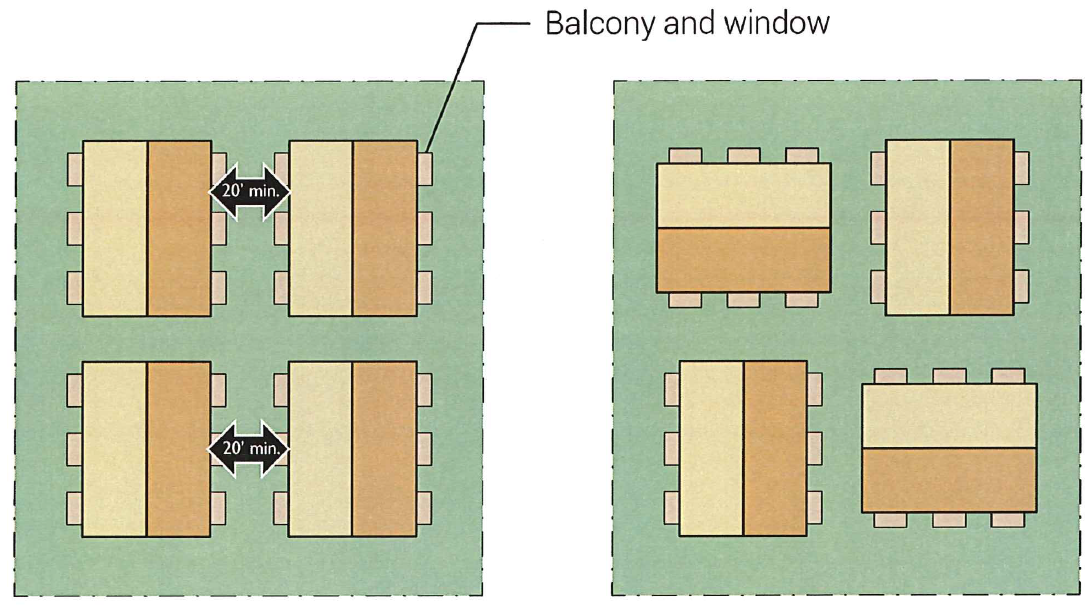
The buildings in the left example, where units and balconies face each other, shall be placed at least 20 feet apart. The configuration of buildings on the right, where units face the side of other buildings and thus feature less privacy impacts, are not subject to the 20-foot setback requirement.
(d) Site Design and Orientation. Dwellings within a multifamily housing development shall be oriented to provide both access and privacy for the residents.
(i) Clear and obvious pedestrian access and visual access between the sidewalk (or the street if there is no sidewalk) and any shared entrance(s) or exterior primary entrances to a unit (if applicable) are required for new multifamily dwellings.
(ii) For all new multifamily dwellings adjacent to a street, see Residential Design Guidelines, especially Sections C.1, C.2.1 and E.5.1.
(e) Building Design and Orientation. See Section E in the Residential Design Guidelines.
(f) Open Space.
(i) Amount of Required Residential Open Space. All new multifamily uses shall either provide on-site open space of 100 square feet per dwelling unit or 10 percent of residential unit floor area (excluding hallways and common areas) that provides functional leisure or recreational activities. (The lesser amount of the two calculations is acceptable.) The open space may be in the form of common open space, balconies, roof decks, indoor recreation spaces or similar features provided they meet the requirements of the Residential Design Guidelines Section C.3. Required setback areas shall count as part of the required open space requirement if they meet the requirements in the Residential Design Guidelines.
(ii) Surface water management facilities may be included in the open space calculation for meeting minimum requirements, if it can be demonstrated that they are designed so that residents can use the space similar to other open space designations.
(g) Access, Parking, and Garages.
(i) Unless a higher classification of road is required per public works preapproved plans or by the city engineer to provide for consistency with the Wenatchee urban area plan, internal access and circulation shall meet the requirements of Fire Apparatus Access Road, of the most current edition of the International Fire Code, as amended. Where a standard residential subdivision or binding site plan is proposed associated with these developments, the standards provided in WCC 11.20.020, Streets, shall also apply.
(ii) Each multifamily dwelling unit shall provide at least one off-street parking space per bedroom, up to two parking spaces per unit.
(iii) Parking areas shall be located to the side or rear of multifamily units (not between the multifamily building and the street front unless no other configuration is feasible, as determined by the director). Landscaping in the form of hedges or architectural barriers is required to screen surface parking lots for neighboring properties and common open spaces.
(iv) Private garages are allowed to be attached to or detached from individual multifamily units if less than 250 square feet in size and accessible by an alley or shared driveway. Private garages shall match the architectural style of the multifamily units.
(v) Enclosed parking areas are encouraged to be clustered, with no more than three parking spaces together within one structure not greater than 800 square feet. Individual garage doors shall be one car width.
(h) Landscaping. Multifamily housing developments shall adhere to the landscape and screening chapter, Chapter 10.62 WCC. See also Residential Design Guidelines Section D.1.
(i) Architectural Design. Conform to the Residential Design Guidelines Section E.
(j) General Storage. Storage of personal property and materials, of residents as well as managers and owners of a development, shall be located outside of required street setback areas, and it shall be entirely within an enclosed building or screened from view of the surrounding properties with a sight-obscuring fence and landscaping. Developments for which WCC 10.48.320 applies shall also meet those standards. (Ord. 2023-09 § 3 (Exh. A); Ord. 2020-35 § 3 (Exh. A); Ord. 2019-35 §§ 6, 9)
10.47.160 Mixed use building.
All mixed use buildings, where defined in WCC 10.08.100 and where allowed by Chapter 10.10 WCC, District Use Chart, shall meet standards applicable to the specific mix of uses integrated into the development or building. These developments shall be subject to standards including, but not limited to, the following:
(1) District development standards of Chapter 10.46 WCC.
(2) Other applicable development standards associated with commercial development within this title.
(3) Multifamily development standards at WCC 10.47.150. (Ord. 2023-09 § 3 (Exh. A); Ord. 2019-35 § 6)
10.47.170 Alley access and improvements.
(1) Alley access is required for all residential development on sites adjacent to alleys where the city engineer determines that the alley is sufficiently improved to provide adequate circulation.
(2) Developments requiring six or more parking spaces accessing an alley shall pave the alley if needed and make necessary stormwater improvements. (Ord. 2019-35 § 6)
10.47.180 Manufactured home communities.
Manufactured home communities use permissions are provided by Chapter 10.10 WCC, District Use Chart. Manufactured home communities are subject to the following standards unless otherwise regulated within this code:
(1) Purpose.
(a) To provide housing types that are responsive to changing household demographics (e.g., retirees, small families, young professionals).
(b) To provide opportunities for more affordable housing within single-family neighborhoods.
(c) To encourage creation of functional usable open space in residential communities.
(d) To promote neighborhood interaction and safety through design.
(e) To ensure compatibility with neighboring uses.
(f) To provide opportunities for infill development consistent with goals of the Wenatchee urban area comprehensive plan.
(2) Standards.
(a) Manufactured home community options include ownership, rental, condominium, and subdivision.
(b) Manufactured homes placed in the manufactured home community shall meet the definition of both “manufactured home” and “manufactured home, designated” found in WCC 10.08.100 and the standards in WCC 10.47.020 in addition to the standards in this section.
(c) Subdivision. Where a manufactured home community involves a subdivision, development parameters as determined by the city shall be placed on the final plat or final unit lot subdivision. Where manufactured home communities involve the lease of various spaces, the layout shall be placed on a binding site plan meeting the standards in WCC Title 11.
(d) Minimum Size of Development and Maximum Size of Cluster.
(i) A single manufactured home community shall be at least two acres in size.
(ii) Up to 12 units may make up a cluster (a grouping of units situated around a common open space or pedestrian circulation network, each with an entry facing the courtyard or pedestrian system).
(e) Maximum Floor Area. The total floor area for a unit in a manufactured home community shall be no larger than 1,500 square feet.
(f) Density. The manufactured home community shall comply with the density of the applicable zoning district.
(g) Setbacks.
(i) Units placed along streets are subject to the applicable street setbacks in Chapter 10.46 WCC.
(ii) Units placed adjacent to side property lines are subject to the applicable side setback.
(iii) Units placed along rear property lines of parent lot(s) shall maintain 10-foot minimum setbacks in the RS and RL zones and five-foot minimum setbacks in all other applicable zones.
(iv) The minimum internal setback between manufactured homes is 10 feet. This includes carports, roofs, decks, etc.
(h) Site Design and Orientation. Dwellings within a manufactured home community shall be oriented to promote a sense of community, both within the development, and with respect to the larger community, outside of the project. The development shall not be designed to “turn its back” on the surrounding neighborhood by locating rear yards to face a public street.
(i) Clear and obvious pedestrian access between the sidewalk (or the street if there is no sidewalk) and the building entry is required for new manufactured homes.
(ii) All new manufactured homes adjacent to a street shall meet the Residential Design Guidelines, especially Sections C.1 (Ground related units facing streets, common pathways, or common open space), C.2.1 (Pedestrian connectivity within multi-unit residential development with more than one building) and E.5.1 (Building entrances: configuration and details).
(iii) Common open space shall be provided in a centrally located focal area for the development and abut at least 50 percent of the units in the development (see open space standards below); direct access to the common open space shall be provided for each unit by a paved walkway. See also Residential Design Guideline Section D.3, Residential open space elements.
(iv) One existing single-family dwelling may be incorporated into a manufactured home community of six or more units as a residence. Nonconforming residences with respect to architectural standards shall be permitted.
(v) A manufactured home community may contain one community building that is clearly incidental in use and similar in size and architectural design of the units. Such community building shall be located on the same site as the development and be commonly owned by the residents.
(vi) Cul-de-sacs are not permitted within a manufactured home community, unless it can be demonstrated that no other configuration is feasible.
(i) Building Design and Orientation. See Section E in the Residential Design Guidelines.
(j) Open Space.
(i) A common open space is required for each cluster of units.
(ii) A minimum of 200 square feet of common open space shall be provided per dwelling unit.
(A) Common open space within a development shall be a minimum of 1,000 square feet in size with no dimension less than 15 feet, regardless of the number of dwelling units.
(B) Common open space shall meet the requirements of the Residential Design Guidelines, especially Section C.3.2.b, and be improved for passive or active recreational use. Examples may include, but are not limited to, courtyards, noncommercial orchards, landscaped picnic areas or gardens, wildlife viewing areas, etc.
(C) Fences are not allowed within any common open space area.
(D) Common open space shall be located in a separate tract or tracts and owned in common by all property owners.
(E) See Figures 10.47.090(1)(a) and (b) for examples.
(iii) Each unit shall include a minimum of 200 square feet of private open space (in addition to common open space). The private open space shall have no dimension less than 10 feet, be located adjacent to the unit which it serves and feature direct access to the private open space via door. Examples include a semi-private garden space between a dwelling and the common open space. See Figures 10.47.090(1)(a) and (b) for examples.
(iv) Surface water management facilities may be included in the open space calculation for meeting minimum requirements, if it can be demonstrated that they are designed so that residents can use the space similar to other open space designations.
(k) Access, Driveways, Parking, and Garages.
(i) At least two parking spaces per dwelling unit or space for a dwelling unit are required to be located on the site following the standards in Chapter 10.60 WCC and the standards below.
(ii) Units adjacent to a street are subject to applicable driveway and garage standards for single-family dwellings in WCC 10.47.050.
(iii) Parking areas shall be located to the side or rear of unit clusters (not between the units and the street front unless no other configuration is feasible, as determined by the director). Landscaping in the form of hedges or architectural barriers is required to screen surface parking lots for neighboring properties and common open spaces.
(iv) Private garages are allowed to be attached to or detached from individual units if less than 250 square feet in size and accessible by an alley or shared access. Private garages shall match the architectural style of the units and meet the same separation requirements as adjoining units.
(v) Enclosed parking areas may be grouped into a single structure. Individual garage doors shall be one car width.
(vi) Unless a higher classification of road is required per public works preapproved plans or by the city engineer to provide for consistency with the Wenatchee urban area plan, internal access and circulation shall meet the requirements of, Fire Apparatus Access Road, of the most current edition of the International Fire Code, as amended. Where a standard residential subdivision or binding site plan is proposed associated with these developments, the standards provided in WCC 11.20.020, Streets, shall also apply.
(l) Where parking areas are clustered in shared arrangements, such parking areas and access lanes are subject to citywide fire-safety and emergency access standards.
(m) Landscaping. Manufactured home communities shall adhere to the landscape and screening chapter, Chapter 10.62 WCC. See also Residential Design Guidelines Section D.1.
(n) Covenants enforced by a homeowner’s association shall be required to include the perpetual maintenance of all common areas, open spaces, and separation between units and accessory structures on adjoining lots/pads; and preclude the conversion to another use. (Ord. 2019-35 § 6)



